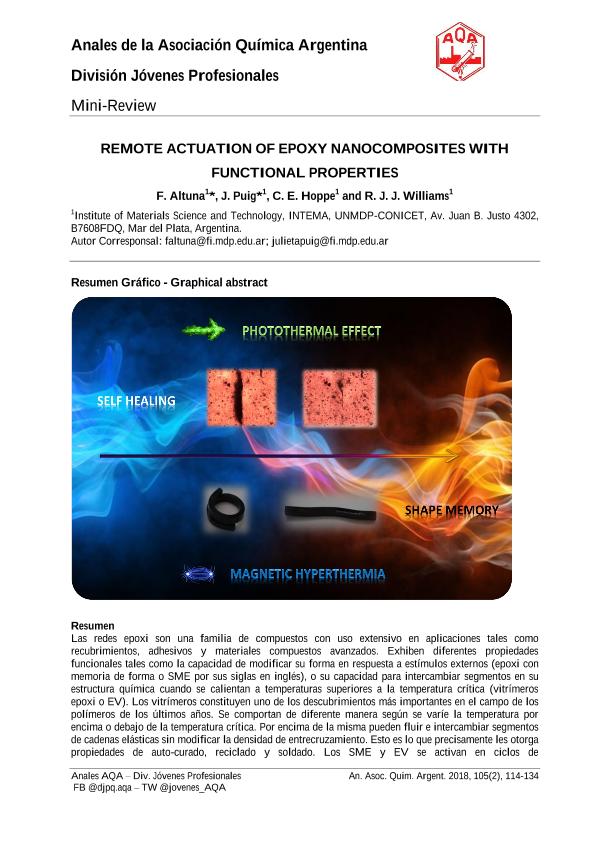Artículo
Las redes epoxi son una familia de compuestos con uso extensivo en aplicaciones tales comorecubrimientos, adhesivos y materiales compuestos avanzados. Exhiben diferentes propiedadesfuncionales tales como la capacidad de modificar su forma en respuesta a estímulos externos (epoxi conmemoria de forma o SME por sus siglas en inglés), o su capacidad para intercambiar segmentos en suestructura química cuando se calientan a temperaturas superiores a la temperatura crítica (vitrímerosepoxi o EV). Los vitrímeros constituyen uno de los descubrimientos más importantes en el campo de lospolímeros de los últimos años. Se comportan de diferente manera según se varíe la temperatura porencima o debajo de la temperatura crítica. Por encima de la misma pueden fluir e intercambiar segmentosde cadenas elásticas sin modificar la densidad de entrecruzamiento. Epoxy networks are one of the most important families of thermosetting polymers with an extensive use as adhesives, coatings and matrices of advanced composites. In recent years, smart materials based on epoxy formulations were developed. They exhibit different functional properties such as the capacity of modifying their shapes in response to an external stimulus (shape-memory epoxies, SME) or the capacity of interchanging segments of their chemical structures when heated above a critical temperature (epoxy vitrimers, EV). Vitrimers are one of the most important recent discoveries in the field of polymers. They behave as conventional thermosets below the critical temperature but they can flow at higher temperatures interchanging segments of elastic chains while keeping a constant crosslink density. This enables their self-healing, recycling and welding as well as the relaxation of strained chains. SME and EV are activated by adequate heating/cooling cycles. Incorporation of specific nanoparticles (NPs) capable of converting IR or visible light radiation into heat (photothermal effect) makes it possible the remote actuation of these smart materials. Similarly, incorporation of magnetic NPs can be used to produce the remote heating by exposure to an alternating magnetic field (magnetic hyperthermia). The photothermal effect provides also the possibility of local heating and, therefore, a local response (e.g., localized shape recovery or the self-healing of a localized area). Besides, the synthesis of smart epoxy nanocomposites requires the appropriate functionalization of NPs to produce their uniform dispersion in the epoxy matrix. In this article, we review recent selected papers dealing with the development of EV and SME nanocomposites that can be remotely activated.
Remote actuation of epoxy nanocomposites with functional properties
Fecha de publicación:
10/2018
Editorial:
Asociación Química Argentina
Revista:
Journal of the Argentine Chemical Society
ISSN:
0365-0375
Idioma:
Inglés
Tipo de recurso:
Artículo publicado
Clasificación temática:
Resumen
Archivos asociados
Licencia
Identificadores
Colecciones
Articulos(INTEMA)
Articulos de INST.DE INV.EN CIENCIA Y TECNOL.MATERIALES (I)
Articulos de INST.DE INV.EN CIENCIA Y TECNOL.MATERIALES (I)
Citación
Altuna, Facundo Ignacio; Puig, Julieta; Hoppe, Cristina Elena; Williams, Roberto Juan Jose; Remote actuation of epoxy nanocomposites with functional properties; Asociación Química Argentina; Journal of the Argentine Chemical Society; 105; 2; 10-2018; 114-134
Compartir




